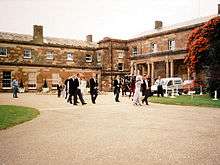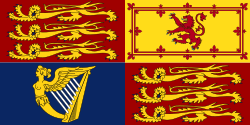Hillsborough Castle
| Hillsborough Castle | |
|---|---|
 The official entrance of Hillsborough Castle | |
 | |
| General information | |
| Location |
Hillsborough, County Down, Northern Ireland, |
| Coordinates | 54°27′41″N 6°05′10″W / 54.46127°N 6.08604°WCoordinates: 54°27′41″N 6°05′10″W / 54.46127°N 6.08604°W |
| Owner | Queen Elizabeth II in right of the Crown[1] |
| Website | |
|
www | |
Hillsborough Castle is an official government residence in Northern Ireland. It is the residence of the Secretary of State for Northern Ireland,[2] and the official residence in Northern Ireland of Her Majesty Queen Elizabeth II and other members of the British Royal Family when they visit the region, as well as a guest house for prominent international visitors.
From 1924 until the post's abolition in 1973, it was the official residence of the Governor of Northern Ireland.[3] Since April 2014, it has been managed by Historic Royal Palaces, and is open to the public on certain dates.[4]
Origins
Hillsborough Castle, which is located in the village of Hillsborough in north-west County Down, is not a true castle. It is a Georgian country house built in the 18th century for the Hill family, Marquesses of Downshire, who owned it until 1922, when the 6th Marquess sold the mansion and its grounds to the British government.[3] In buying it, the government solved a practical problem. Under the Government of Ireland Act 1920 a new, distinct region of the United Kingdom called Northern Ireland had been created within the traditional province of Ulster. Executive authority had been vested for both Northern Ireland and sister region Southern Ireland in the Lord Lieutenant of Ireland, who was supposed to be one of two all-Ireland features (along with the Council of Ireland) in the new home rule structure. However, that office was abolished in a law change following the Anglo-Irish Treaty of 1921, which in effect abolished Southern Ireland (which had in reality largely existed on paper) and replaced it with the Irish Free State.
A new office for Northern Ireland alone was created to fill the void, that of Governor of Northern Ireland. As the Viceregal Lodge in Dublin became unavailable, physically and politically, a new residence was needed. Hillsborough Castle, though outside the largest city of Northern Ireland, Belfast, was deemed a suitable location. After some renovations, the first governor, The 3rd Duke of Abercorn, moved in during 1925. Upon becoming the official residence of the governor, the building was officially renamed Government House.
Secretary of State
Following the decision to abolish Northern Ireland's devolved system of government and institute direct rule from London, all Northern Irish governmental posts, including that of Governor and Prime Minister of Northern Ireland, were abolished. Those two posts were in effect combined to create the office of Secretary of State for Northern Ireland. As the Queen's representative, the Secretary of State resides in Hillsborough Castle – as do junior ministers, though members of the Royal Family, when visiting Northern Ireland, stay there also.
Queen Elizabeth and HRH The Duke of Edinburgh stayed in Hillsborough Castle during their visit to Northern Ireland as part of the Golden Jubilee tour of the United Kingdom in 2002.[3]
Investitures
In 2014 the Prince of Wales held an investiture at Hillsborough Castle, the first one to be held in Northern Ireland since the venue became a Royal Palace.[5]
Anglo-Irish Agreement
Hillsborough Castle became the controversial location of the signing of the Anglo-Irish Agreement on November 15th, 1985.[6] Irish Taoiseach (prime minister) Garret FitzGerald believed that signing the Agreement in Hillsborough Castle would mollify unionist opposition to the Agreement somewhat. However, many unionists took offence at the signing of the Agreement in the Throne Room of the castle, igniting their opposition further.
Political talks

Many of the crucial talks leading up to the signing of the Belfast Agreement took place in the secretariat attached to the castle. Leaders such as Gerry Adams (Sinn Féin), John Hume (Social Democratic and Labour Party), David Trimble (Ulster Unionist Party) and, on occasion, The Rev. Ian Paisley (Democratic Unionist Party) met Secretaries of State to discuss sensitive political and constitutional issues. It was also used in January 2010 for talks between British Prime Minister Gordon Brown, Irish Taoiseach Brian Cowen and representatives of the Democratic Unionist Party and Sinn Féin over the crisis over Northern Irish policing which threatened to derail the Northern Irish government.
Breaking new ground
Mo Mowlam[note 1] broke new ground when she opened the extensive grounds of the castle to the public. Previous Secretaries of State had not done so because of the fear of Provisional IRA attack. The security impact on the castle can be seen (top photo) in the presence of bullet-proof glass in plastic frames in front of the Georgian windows at the public front of the building.
Prominent visitors

Apart from members of the British Royal Family and politicians from Northern Ireland, elsewhere in the United Kingdom or from the Republic of Ireland, some international figures have visited or stayed at the castle. The then President of the United States, George W. Bush, visited the castle in 2003.
Footnotes
- ↑ Following her death on 18 August 2005, Mowlam's ashes were scattered at Hillsborough Castle
See also
References
- ↑ "History". Historic Royal Palaces. Retrieved 22 July 2013.
- ↑ "Hillsborough Castle and Gardens". Tourism Ireland. Retrieved 27 December 2009.
- 1 2 3 "Virtual Tour Hillsborough Castle". Northern Ireland Office. Retrieved 27 December 2009.
- ↑ "Hillsborough Castle". Who we are. Historic Royal Palaces. 2014. Retrieved 26 January 2015.
- ↑ "Prince of Wales gives OBE and MBE honours at Hillsborough Castle". BBC News.
- ↑ https://www.britannica.com/event/Anglo-Irish-Agreement
External links
| Wikimedia Commons has media related to Hillsborough Castle. |


.svg.png)